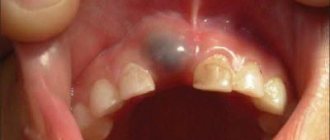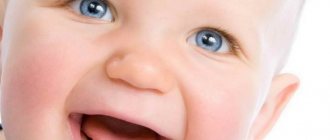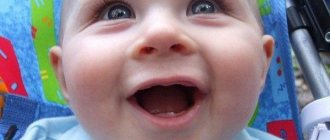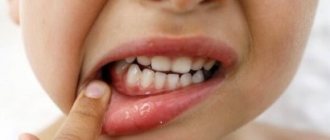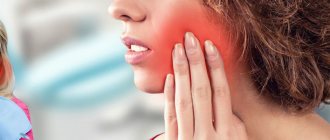Author of the article:
Soldatova Lyudmila Nikolaevna
Candidate of Medical Sciences, Professor of the Department of Clinical Dentistry of the St. Petersburg Medical and Social Institute, Chief Physician of the Alfa-Dent Dental Clinic, St. Petersburg
In the life of every baby and every mother, there comes an exciting moment when the first teeth erupt. And, alas, along with the joy of a new independent stage in the life of a child, new problems interfere in the lives of children and parents. The child's first tooth is accompanied by a very painful condition. Is it possible to alleviate these unpleasant manifestations of growing up? Of course you can. How? Let's figure it out together.
When do the first teeth appear?
Usually a baby's first baby tooth is at 6 months. Although some children have their first teeth appearing as early as 4 months of age, others have to wait as long as 7 months for their first incisors. By the way, both such an early and such a late appearance is considered the norm. At 6-8 months, the central lower incisors appear.
- At 8-12 months, the central upper incisors grow;
- 10-13 months – second upper and lower incisors;
- 1-1.5 years – primary molars;
- 1.5-2 years – fangs;
- 2-2.5 years – second primary molars.
Thus, by the age of two, the baby already has 18 teeth in its mouth. But it is the first incisors that cause the baby the most inconvenience.
Features of caring for first teeth
Maintaining oral hygiene is necessary to preserve baby teeth until permanent teeth appear. These procedures should be started not when all the baby teeth have erupted, but after the first one appears. Special dental wipes, which are impregnated with a sweetener - xylitol, are well suited for this purpose. These napkins have a good fruity aroma and taste.
You can buy a children's toothbrush when your baby has 4 teeth in his mouth. This should be a special brush with soft bristles. It is not recommended to use toothpaste until your child reaches two years of age. In this case, you just need to moisten the brush with warm water (necessarily boiled). Rinse solutions should also not be used.
Caring for baby teeth
To prevent dental caries, you need to limit the amount of sweets you eat. It is also advisable to exclude sweet tea from your child’s diet. Instead, it is better to give boiled water with a little lemon juice. This fortified drink will improve your baby’s well-being and strengthen his immune system. It is advisable to teach a child hygiene from an early age, showing how to properly brush his teeth and wash his face. This will avoid many health problems in the future. My gums hurt, what to do, read the article.
How to understand that teeth have started to cut?
The following symptoms will indicate that a child is getting his first baby tooth:
- severe crying, frequent whims of the baby;
- increased salivation;
- slight increase in temperature;
- frequent excitability;
- refusal of food;
- upset stomach (diarrhea).
Of course, the above symptoms individually can indicate not only that the child is getting his first teeth. For example, whims and frequent excitability in a baby can be caused by stress due to moving to a new apartment, fever by a cold, and diarrhea by an allergy to a particular product. Usually, the eruption of the first teeth in children provokes several, or even all, of these signs at once.
All about teething in babies...
...and children in the first years of life. So I was happy early on - the first two lower teeth came out without any problems, and I was already glad that everything was okay with us. But that was not the case... For half a day now, my Mashulya has been restless... hot (temp 37.8 and liquid poop)))). Saliva streamed, and whining, whining, whining... The doctor denied any disease. There is only one diagnosis: teeth. So I scoured the Internet and found some information. How to recognize, distinguish and act correctly. Maybe it will be useful to someone... Teething in children in the vast majority of cases begins at the age of 4-7 months and occurs in a more or less precise sequence (incisors, premolars, canines, molars). And small deviations from this period should not alarm parents. Many children become restless and capricious during teething. Often, against the background of teething, the child develops profuse salivation, inflammation of the gums, fever, mild runny nose, wet cough or diarrhea. To facilitate teething, it is recommended to give the child special rubber rings or toys to develop the gums, and in case of severe gum pain, use special pain-relieving gels. Typically, teeth appear in the following order: first incisors (upper and lower), second incisors (upper and lower), first molars (upper and lower), canines (upper and lower), and finally second molars ( top and bottom). By age 3, a child should have a full row of 20 teeth, which should not fall out until about 6 years of age, when permanent teeth are ready to emerge. Just like the timing of teething, the symptoms that accompany this process can be very diverse in different children and even change from case to case in the same child. For many children and their parents, the process of teething is quite difficult and painful; in other cases, the child does not show any signs of teeth appearing all the time, and happy parents notice his “new things” completely by accident.
The first signs of teething are heavy salivation and painful, swollen gums. These teething symptoms may occur as early as a month or two before the tooth can be seen. Because of the discomfort and pain, some children may sleep restlessly, be fussy, lose their appetite, and want to chew on hard objects or put their fingers in their mouth. Closer to the moment the tooth appears, you can notice a whitish protrusion or a thin white line on the gum, which produces a characteristic ringing clicking sound if you gently tap it with a teaspoon (some enterprising parents sometimes do this).
Diarrhea, runny nose, cough and fever as symptoms of teething - Doctors differ on whether teething causes symptoms such as diarrhea, runny nose, wet cough and fever. Despite the fact that in certain cases the connection between the deterioration of the child’s condition and the appearance of teeth is almost obvious, most doctors do not include fever, runny nose, cough and diarrhea in the list of possible manifestations of teething. This attitude has a logical explanation: in many cases, teething in children can last the first 2-3 years of life and coincides with the period of greatest risk of various infections, and therefore it is incorrect and dangerous to “write off” every episode of fever, cough, diarrhea or runny nose due to teething. However, an increase in temperature, the appearance of a runny nose, mild diarrhea and a wet cough against the background of teething is possible and occurs quite often.
An increase in temperature during teething is associated with the release of a large amount of biologically active substances in the tooth growth zone. In most cases, the increase in temperature during teething does not exceed 38.5 C - 39 C and lasts no more than 1-2 days. To reduce fever in children, it is recommended to use Paracetamol. In all cases when the child’s temperature exceeds 39 C or lasts more than 2 days, he should be shown to a doctor. The appearance of diarrhea during teething is explained by strong salivation (the child swallows a lot of saliva) and accelerated intestinal motility. Diarrhea due to teething is usually watery, not very frequent (up to 2-3 times a day) and lasts no more than 1-3 days. In all cases when a child experiences frequent watery or bloody diarrhea (more than 3 times a day), characteristic of an intestinal infection, the child should be shown to a doctor. See also Diarrhea.
The appearance of a runny nose during teething is explained by increased secretion of mucus by the glands of the nasal cavity. A runny nose due to teething is watery (the mucus is clear and runny), not very profuse and lasts no more than 3-4 days. Treatment of a runny nose in children during teething is best limited to clearing the nose of mucus. See also Runny nose. In all cases when a child has a profuse purulent (greenish or whitish runny nose) which is accompanied by severe nasal congestion and lasts more than 3 days, the child should be shown to a doctor.
The appearance of a wet cough during teething is explained by the accumulation of saliva in the throat, which is released in large quantities during teething. A wet cough during teething is quite rare, worsens when lying down and goes away within 2-3 days. This cough does not require any treatment. In all cases, when a child’s wet cough becomes frequent, is accompanied by the production of copious sputum, wheezing in the bronchi, shortness of breath, and lasts more than 2 days, the child should be shown to a doctor.
In order not to confuse teething with any disease, we recommend that all inexperienced parents call a doctor in all cases of fever, runny nose, diarrhea or cough in the child.
How can you help your baby during teething? During this difficult period for the child, parents should support him, pick him up more often, caress him, and distract him from the pain with interesting activities. If your baby is breastfed, he can be easily soothed by offering the breast. Most breastfed babies ask for the breast much more often during teething compared to normal days. You should not refuse your child, and especially you should not try to set any schedule these days or try to wean your child off the breast. Typically, such a “difficult period” lasts no more than 2-3 days. During teething, children often feel the urge to gnaw or chew on something. This helps them relieve discomfort. Offer your child a special rubber ring or other elastic rubber toy. Many sources recommend chilling the rubber ring in the freezer before giving it to your child. However, it is worth noting that many children do not like cold objects or are not at all interested in special toys for warming up their gums and choose their favorite object for this. In this case, you should not insist and give the child special rings. Just make sure that the item your child chooses does not have sharp ends that could cut the child or small parts that could cause a choking hazard. Some children prefer to chew on a crust of bread or a bagel while teething. Children switch very quickly from one mood to another. A child who has just sobbed with all his might can easily laugh and vice versa. Therefore, the best way to relieve a child's pain is to distract him from it. Find an interesting activity for your child, play with him, take a walk, and he will quickly forget about his discomfort. You should not think that if, when you feel bad, you prefer to lie in silence and relax, then this will be the best option for your child.
In case of severe soreness of the gums, which is manifested by severe crying, anxiety, and the child’s refusal to eat, you can use special gels designed to eliminate pain during teething. It is convenient to apply such gels to the child’s gums with your finger, gently massaging them.
If a child has the above symptoms that last more than 1-2 days, be sure to show the child to a doctor. There are cases when doctors do not find any disease and then it can be assumed that it could be caused by teething. However, in many cases, these symptoms are caused by a serious illness, such as otitis media, food poisoning, viral infection, etc. Therefore, you should not immediately write off the signs of the disease as teething, because this way you may miss a serious disease, which can result in extremely unpleasant consequences. The body of a small child is not yet able to cope with many diseases, so if there are obvious signs of illness, it is better to consult a doctor once again than to go too late.
Of all the manifestations of teething described above, only temperature requires treatment and only if it rises above 38.5 C. Runny nose, cough or diarrhea caused by teething do not require any treatment.
When should you worry?
The listed signs of the appearance of the first baby tooth should not bother mom, dad and grandmother too much. The following symptoms may be a reason to contact your pediatrician:
- Early appearance of the first teeth. In rare cases, newborns develop teeth immediately after birth. This may indicate endocrine pathology and requires examination by an endocrinologist.
- A significant delay in teething may also indicate various metabolic disorders in children and requires medical intervention.
- Incorrect appearance order . If, instead of the baby’s first incisors, molars or fangs begin to peck, such disharmony may indicate anomalies in the baby’s development or be a consequence of illnesses that the woman suffered during pregnancy.
- Temperature above 39 degrees. When the first teeth erupt in children, the temperature rises slightly. If your baby becomes hot and the high temperature lasts for several hours, call a doctor immediately.
What affects the timing of eruption
There are many factors that can affect the timing of a baby’s first teeth. These include:
- gender of the baby. It's no secret that boys develop teeth a little later than girls;
- climatic features of the region in which the child lives. According to statistics, teeth erupt earlier in those children who live in hot climates;
- child's diet. For example, a lack of calcium in the body can slow down the teething process;
- hereditary factor.
Baby is cutting teeth
Almost always, the incisors are the first to appear from a baby’s gums – pediatricians remain unanimous on this. But in rare cases, other teeth may erupt first. There is no need to immediately panic, since each organism is unique and tooth growth does not always occur according to a certain schedule.
How to help your baby?
To alleviate the symptoms accompanying teething in a child, parents can use one of the following methods:
- Let your baby chew on a crust of bread . Such manipulations will provide gum massage. However, you need to carefully monitor your child so that he does not choke on the spicy crumbs.
- Wipe off saliva from your baby's skin every half hour . Excessive salivation irritates the skin and can lead to rashes, dry skin and allergic reactions.
- Massage your baby's gums . If your baby is suffering from pain and inflammation of the gums, try gently massaging the gums with a clean finger. But, before you start the massage, remember not to lubricate fragile baby gums with alcohol or apply tablets to the tissues.
What time do the first teeth appear?
As a rule, the first teeth can be expected at the age of 6-7 months, and the eruption sequence looks something like this.
Timing of teething
After the first tooth appears, you need to wait 3 to 4 weeks until the second one grows in the neighborhood. By about 12 months of age, the baby should have 8 front incisors in his mouth. But these are only average statistical data, therefore, even if by this age only 6 teeth have erupted, this is not scary.
Until recently, dentists explained the late eruption of the first teeth by the fact that there are not enough useful substances in the body, including calcium. Also, such deviations were associated with the child’s predisposition to rickets. Now no one considers late eruption to be some kind of deviation, since this phenomenon can be observed in completely healthy children. Typically, 3-year-old children already have all their baby teeth in their mouths.
Baby teeth in a child
On a note! There is a special formula that doctors use to determine the required number of teeth that have erupted in babies. It looks like this: P=N-6, where N is the number of months of the child’s life, and P is the number of teeth placed. For example, an 8-month-old baby should have 2 baby teeth in his mouth.
Child's dental formula
You may also be interested in
CHILDHOOD
Finger wipes from 0 to 3 years ASEPTA BABY
For gentle oral hygiene of babies and massage of gums during the eruption of the first teeth
More about the product
CHILDHOOD
Children's gel toothpaste from 0 to 3 years ASEPTA BABY
Designed for gentle care of baby's gums and baby teeth
More about the product
Asepta Baby wet wipes with xylitol, calcium pantothenate, chamomile and witch hazel extract, intended for children 0-3 years old, will be effective pain-relieving assistants and an alternative to a toothbrush for little ones.
The napkin perfectly cleans all surfaces in the oral cavity, reduces the risk of inflammation and prevents the growth of bacteria in the oral cavity.
How to relieve symptoms
Relieving the baby’s condition when the first teeth appear is not an easy task. But for this purpose there are special recommendations, the observance of which will make the teething process less unpleasant.
Teething
First of all, you need to purchase special toys - teethers, thanks to which the child's need for chewing will be satisfied. Such products contain a gel or liquid filler, which, when cooled, can eliminate burning and itching in the gums. Despite all the advantages, teethers have one drawback - the toy constantly needs to be cooled.
Teethers that effectively relieve itching and stimulate tooth growth
Using bottles and pacifiers will also satisfy your baby's desire to chew on surrounding objects. But when choosing such nipples, one factor must be taken into account, namely their shape. If the shape of the pacifier is chosen incorrectly, then regular chewing can lead to malocclusion. To prevent such phenomena, doctors recommend purchasing special orthodontic pacifiers made of latex or silicone. Avoid fakes, because they are often made from harmful and toxic materials that will harm the health of the child.
Use of pharmaceuticals
Of course, not all measures help eliminate or at least facilitate teething in children, but the most effective auxiliary means are medications. In dental practice, various forms of topical preparations are used (ointments, gels, creams, etc.). Let's look at the most common medications that have stood the test of time. Most of them contain lidocaine as an active substance, which, if used incorrectly, can harm the baby's health. Therefore, all actions must be coordinated with a doctor.
Children's teeth gels
Table. Effective medications to combat teething symptoms.
| Name of the drug, photo | Description |
| Dantinorm baby | A strong homeopathic drug with analgesic and anti-inflammatory properties. Regular use of this product will eliminate problems with the digestive system. The drug is available in the form of a solution, due to which the effect it provides is longer lasting. |
| Kalgel | The active component of this dental gel is lidocaine. Kalgel has analgesic properties, so it is actively used to relieve teething symptoms. Prescribed for children from 5 months. It is recommended to apply the gel to the affected area 5-6 times a day. |
| Holisal | Another drug in gel form that has an anti-inflammatory effect on the patient’s body. Unlike its analogues, Cholisal gel contains choline salicylate components, which allows you to achieve maximum results during treatment. It is recommended to apply the product to the gum surface 3 times a day. |
| Baby Doctor | Hypoallergenic drug made on a plant basis. Has anti-inflammatory and analgesic properties. The drug has no contraindications, so it is prescribed to children of any age. |
| Dentinox | The composition of this dental preparation, produced in the form of a gel, includes chamomile and lidocaine. Dentinox has anti-inflammatory properties. It is recommended to treat the affected gum area with it 3 times a day. In rare cases, it can cause an allergic reaction in a child. |
| Solcoseryl | An excellent anti-inflammatory drug used in dental practice. The gel is prescribed for the treatment of open wounds on the surface of the gums. Thanks to its active components, Solcoseryl accelerates the healing process and relieves pain. |
When using one or another medication, the risk of side effects cannot be completely eliminated. In order to prevent this from happening, you must coordinate all your actions with your doctor. In addition, you need to take into account the general condition of the child and his health, and use this or that medicine. Otherwise, complications may arise.
NatraBio, liquid teething pain relief for children
other methods
In addition to traditional teethers or medications, doctors often recommend performing a special gum massage. It is carried out using a gauze swab moistened with cool water. Regular implementation of this procedure will clear the baby’s mouth of germs and eliminate itching in the gums.
- How long does it take for drugs to leave the body?
All massage movements should be neat, gentle and gentle. Any sudden or careless movement can injure the baby’s already painful gums. Instead of a tampon, you can use a special product - a finger brush.
Silicone fingertip
Experts' opinion
The effectiveness of ASEPTA wipes has been proven in the laboratories of the VERTEX company. Products have:
- Certificate of Conformity No. ROSS RU.AG81.N01070;
- Certificate of Conformity No. ROSS KR.AG81.H01815;
- Certificate of state registration No.RU.47.01.05.014.E.000002.01.18.
In addition, a study of the clinical effectiveness of the use of therapeutic and prophylactic agents of the ASEPTA series in the treatment of inflammatory periodontal diseases in children and adolescents, conducted at the Department of Pediatric Dentistry of the Novosibirsk State Medical University, proved that after the use of Asepta therapeutic and prophylactic agents in children There was a decrease in signs of inflammation in periodontal tissues (disappearance of swelling, bleeding gums).




